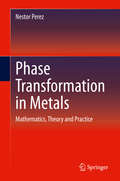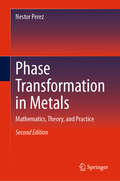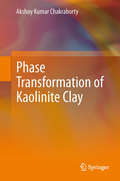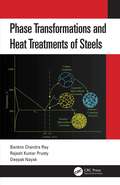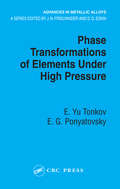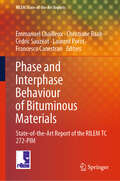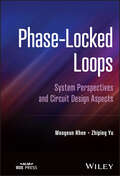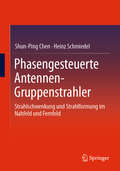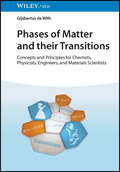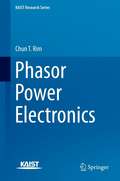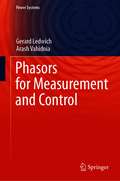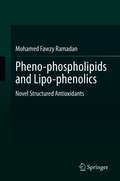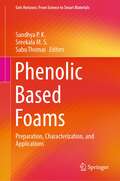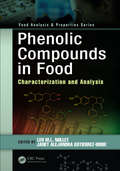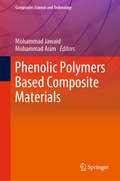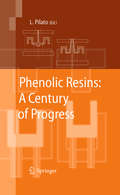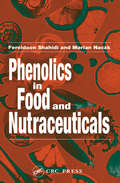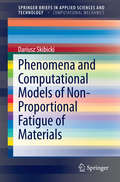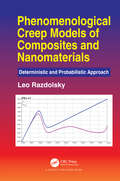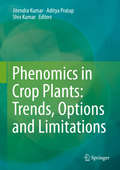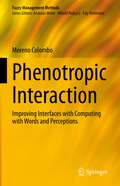- Table View
- List View
Phase Transformation in Metals: Mathematics, Theory and Practice
by Nestor PerezThis textbook explains the physics of phase transformation and associated constraints from a metallurgical or materials science point of view, based on many topics including crystallography, mass transport by diffusion, thermodynamics, heat transfer and related temperature gradients, thermal deformation, and even fracture mechanics. The work presented emphasizes solidification and related analytical models based on heat transfer. This corresponds with the most fundamental physical event of continuous evolution of latent heat of fusion for directional or non-directional liquid-to-solid phase transformation at a specific interface with a certain geometrical shape, such as planar or curved front. Dr. Perez introduces mathematical and engineering approximation schemes for describing the phase transformation, mainly during solidification of pure metals and alloys. Giving clear definitions and explanations of theoretical concepts and full detail of derivation of formulae, this interdisciplinary volume is ideal for graduate and upper-level undergraduate students in applied science, and professionals in the metal making and surface reconstruction industries.
Phase Transformation in Metals: Mathematics, Theory, and Practice
by Nestor PerezThis new edition retains its class-tested explanation of the physics of phase transformation and associated constraints from a metallurgical/materials science point of view, and adds an enhanced treatment of the underlying theoretical concepts with greater clarification. The new edition continues its examination of crystallography, mass transport by diffusion, thermodynamics, heat transfer and related temperature gradients, thermal deformation, and even fracture mechanics. The work presented emphasizes solidification and related analytical models based on heat transfer. This corresponds with the most fundamental physical event of continuous evolution of latent heat of fusion for directional or non-directional liquid-to-solid phase transformation at a specific interface with a certain geometrical shape, such as planar or curved front. Dr. Perez introduces mathematical and engineering approximation schemes for describing the phase transformation, mainly during solidification of pure metals and alloys. Giving clear definitions and explanations of theoretical concepts and full detail of derivation of formulae, this interdisciplinary volume is ideal for graduate and upper-level undergraduate students in applied science, and professionals in the metal making and surface reconstruction industries.
Phase Transformation of Kaolinite Clay
by Akshoy Kumar ChakrabortyThe book depicts comprehensive studies on thermal decomposition of Kaolinite by different physico-chemical methods carried out by various scientists in last 100 years and results of the studies conducted by author in past 33 years. It also provides a critical analysis of different views on Kaolinite-Mullite reaction series, characterization of controversial spinel phase in Kaolinite-Mullite reaction series and explanation of DTA events of Kaolinite. The book helps both researchers and students to realise the new mechanism of transformation of Kaolinite to Mullite. The new reaction processes discussed in the book also help ceramic experts to synthesize Mullite grains in commercial way for production of Mullite porcelain and Mullite refractory.
Phase Transformations and Heat Treatments of Steels
by Bankim Chandra Ray Rajesh Kumar Prusty Deepak NayakThe perpetual flow of understanding between phase transformation that controls grain/microstructures and heat treatment which decides the size of grains/microstructures of steels is not well articulated in the perspective of undergraduate students. In Phase Transformations and Heat Treatments of Steels, theories of phase transformation have been used to obtain a desirable phase or combination of phases by performing appropriate heat treatment operations, leading to unification of both the concepts. Further, it includes special and critical heat treatment practices, case studies, local and in-service heat treatments, curative and preventive measures of heat treatment defects for several common and high-performance applications. Features: Presents fundamentals of phase transformation in steels Analyzes basics of phase transformation due to heat treatment of steel under various environmental conditions Explains application of heat treatment for different structural components Discusses heat treatment defects and detection Emphasizes heat treatment of special steels and in-situ heat treatment practices
Phase Transformations of Elements Under High Pressure (Advances in Metallic Alloys)
by E. Yu Tonkov E.G. PonyatovskyAs laboratories replace heavy hydraulic presses and bulky high-pressure chambers with miniature diamond anvils, traditional heaters with laser heating, and continue to improve methods of shock compression, there has been considerable new data obtained from the high-pressure, high-temperature modification of pure elements. The dense metallic modification of elements shows the potential for achieving superconductivity akin to theoretical predictions.Phase Transformations of Elements Under High Pressure contains the latest theoretical and experimental information on nearly 100 elements, including first-and second-phase transitions, melting lines, crystal structures of stable and metastable phases, stability of polymorphic modifications, and other useful properties and data. It emphasizes features such as changes in the liquid state, amorphization, and metallization, and provides temperature-pressure diagrams for every element. The book also describes the transitions of polymeric forms of fullerene, crystal modifications of elements stable under high pressures, and provides data that confirms their superconducting and magnetic properties.This handbook will be a lasting reference for scientists in a broad range of disciplines, including solid-state physics, chemistry, crystallography, mineralogy, and materials science.
Phase Transitions in Materials
by Brent FultzOffering a fresh viewpoint on phase changes and the thermodynamics of materials, this textbook covers the thermodynamics and kinetics of the most important phase transitions in materials science, spanning classical metallurgy through to nanoscience and quantum phase transitions. Clear, concise and complete explanations rigorously address transitions from the atomic scale up, providing the quantitative concepts, analytical tools and methods needed to understand modern research in materials science. Topics are grouped according to complexity, ensuring that students have a solid grounding in core topics before they begin to tackle more advanced material, and are accompanied by numerous end-of-chapter problems. With explanations firmly rooted in the context of modern advances in electronic structure and statistical mechanics, and developed from classroom teaching, this book is the ideal companion for graduate students and researchers in materials science, condensed matter physics, solid state science, and physical chemistry.
Phase Transitions in Materials: Advanced Topics
by Brent FultzThe new edition of this popular textbook provides a fundamental approach to phase transformations and thermodynamics of materials. Explanations are emphasised at the level of atoms and electrons, and it comprehensively covers the classical topics from classical metallurgy to nanoscience and magnetic phase transitions. The book has three parts, covering the fundamentals of phase transformations, the origins of the Gibbs free energy, and the major phase transformations in materials science. A fourth part on advanced topics is available online. Much of the content from the first edition has been expanded, notably precipitation transformations in solids, heterogeneous nucleation, and energy, entropy and pressure. Three new chapters have been added to cover interactions within microstructures, surfaces, and solidification. Containing over 170 end-of-chapter problems, it is a valuable companion to graduate students and researchers in materials science, engineering, and applied physics.
Phase Transitions in Solids Under High Pressure
by Vladimir Davydovich Blank Emmanuel Isakovich EstrinThe use of high-pressure techniques has become popular for studying the nature of substances and phenomena occurring in them, especially as a means of obtaining new materials (synthesis under high pressure) and processing known materials (hydroextrusion). A product of many years of research by the authors and their colleagues, Phase Transitions in
Phase and Interphase Behaviour of Bituminous Materials: State-of-the-Art Report of the RILEM TC 272-PIM (RILEM State-of-the-Art Reports #43)
by Francesco Canestrari Laurent Porot Christiane Raab Emmanuel Chailleux Cédric SauzéatThis book presents the work of the RILEM Technical Committee 272-PIM on Phase and Interphase behaviour of Bituminous Materials and showcases advances and innovations in the field of bituminous materials for flexible pavements. The first section delves into complex and combined binders, unravelling intricate phenomena and shedding light on the unique challenges posed by these materials. Through meticulous cross-testing, the fundamental physical processes are better understood. The second section addresses the low-temperature performance of bituminous mixtures, exploring important behaviour regarding the longevity and resilience of bituminous pavements. The use of innovative methodologies, particularly the restrained shrinkage test exploited using a three-dimensional perspective, enriches the understanding regarding the mechanical behaviour at cold temperatures. The third section delves into dynamic interlayer shear testing, providing a comprehensive guide to evaluate the bonding behaviour of bituminous interlayers under cyclic loadings. By considering the multiphase nature of road materials and structures, the book not only fills gaps in existing knowledge but also lays the foundation for the development of more durable materials. Its emphasis on a performance-driven and internationally validated approach makes it a reference tool for those contributing to the advancement of sustainable materials in the field of bituminous material engineering.
Phase-Locked Loops: System Perspectives and Circuit Design Aspects
by Woogeun Rhee Zhiping YuPhase-Locked Loops Discover the essential materials for phase-locked loop circuit design, from fundamentals to practical design aspects A phase-locked loop (PLL) is a type of circuit with a range of important applications in telecommunications and computing. It generates an output signal with a controlled relationship to an input signal, such as an oscillator which matches the phases of input and output signals. This is a critical function in coherent communication systems, with the result that the theory and design of these circuits are essential to electronic communications of all kinds. Phase-Locked Loops: System Perspectives and Circuit Design Aspects provides a concise, accessible introduction to PLL design. It introduces readers to the role of PLLs in modern communication systems, the fundamental techniques of phase-lock circuitry, and the possible applications of PLLs in a wide variety of electronic communications contexts. The first book of its kind to incorporate modern architectures and to balance theoretical fundamentals with detailed design insights, this promises to be a must-own text for students and industry professionals. The book also features: Coverage of PLL basics with insightful analysis and examples tailored for circuit designers Applications of PLLs for both wireless and wireline systems Practical circuit design aspects for modern frequency generation, frequency modulation, and clock recovery systems Phase-Locked Loops is essential for graduate students and advanced undergraduates in integrated circuit design, as well researchers and engineers in electrical and computing subjects.
Phasengesteuerte Antennen- Gruppenstrahler: Strahlschwenkung und Strahlformung im Nahfeld und Fernfeld
by Shun-Ping Chen Heinz SchmiedelIn diesem Buch werden die Grundlagen der Strahlformung von Antennen erläutert. Die Prinzipien der Strahlfokussierung und Strahlschwenkung im Nah- und Fernfeld werden mit 2D- und 3D-Simulationen visualisiert und mit Messergebnissen verglichen. Neben linearen und planaren Antennen-Gruppenstrahlern werden auch konforme Gruppenstrahler, also konkave und konvexe Antennen-Gruppenstrahler, die für bestimmte Anwendungen geeignet sind, untersucht und vorgestellt. Auch verwandte Anwendungen der Strahlformung, wie Open-Loop- und Closed-Loop-Antennen-Gruppenstrahler oder Massive MIMO, eine der bahnbrechenden Technologien für 5G und zukünftiges 6G, die eine extrem große Anzahl von Antennenelementen für die Multi-Nutzer-Funkversorgung erfordert, werden behandelt. Weiterhin wird auch Strahlformung der sogenannten ausgedünnten Antennen-Gruppenstrahler mit großen Abständen zwischen den Antennenelementen diskutiert. Dieses Buch richtet sich sowohl an Forschungs- und Entwicklungsingenieure als auch an Studierende in den Bereichen Hochfrequenztechnik und Telekommunikation.
Phases of Matter and their Transitions: Concepts and Principles for Chemists, Physicists, Engineers, and Materials Scientists
by Gijsbertus de WithPhases of Matter and their Transitions An all-in-one, comprehensive take on matter and its phase properties In Phases of Matter and their Transitions, accomplished materials scientist Dr. Gijsbertus de With delivers an accessible textbook for advanced students in the molecular sciences. It offers a balanced and self-contained treatment of the thermodynamic and structural aspects of phases and the transitions between them, covering solids, liquids, gases, and their interfaces. The book lays the groundwork to describe particles and their interactions from the perspective of classical and quantum mechanics and compares phenomenological and statistical thermodynamics. It also examines materials with special properties, like glasses, liquid crystals, and ferroelectrics. The author has included an extensive appendix with a guide to the mathematics and theoretical models employed in this resource. Readers will also find: Thorough introductions to classical and quantum mechanics, intermolecular interactions, and continuum mechanics Comprehensive explorations of thermodynamics, gases, liquids, and solids Practical discussions of surfaces, including their general aspects for solids and liquids Fulsome treatments of discontinuous and continuous transitions, including discussions of irreversibility and the return to equilibrium Perfect for advanced students in chemistry and physics, Phases of Matter and their Transitions will also earn a place in the libraries of students of materials science.
Phasor Power Electronics
by Chun T. RimThis book presents a comprehensive introduction to the principles ofpower electronics, focusing on the switched transformer concept and phasortransformation techniques as employed in the analysis and design of power electronic circuits. Phasor transformations, asintroduced in this book, make the time-varying nature of a switching convertersimple and easy to handle, transforming it into an equivalent time-invariantcircuit. The book starts with an introduction to the philosophy and fundamentalprinciples of power electronics. The switched transformer concept, which isapplicable to any switching converter, is introduced, and it is shown how DC-DCconverters analyses are then so straightforward that very little equationalmanipulation is needed. Then the phasor transformation techniques arecomprehensively explained over three parts. Single phase and multi-phase ACsystems are dealt with through the single phase phasor transformation andcircuit DQ transformation, respectively. A general unified phasor transformationis then introduced for the static and dynamic cases. The final part of the bookconsiders current and potential extensions of the technique in various fieldsof application, including wireless power transfer, signal processing, powersystems and renewable energy. The book avoids the piece-wise linear circuit models used in othertitles, with which the mathematical results become too complicated to be usedin practice. No cumbersome equations or matrix manipulations are needed withthe phasor transformation techniques introduced in this book. It will be avaluable reference source for engineering students and practising researchersin power electronics and related areas.
Phasors for Measurement and Control (Power Systems)
by Gerard Ledwich Arash VahidniaThis book is focused on the development of Phasor Measurement Units (PMUs) as a tool to analyse and control power systems. The book develops a nonlinear system-wide approach to control using PMU signals and provides numerous examples of different power systems to demonstrate the robustness of the approach in comparison to heuristic optimization. Some of the applicable controls include:· Excitation systems;· Wind power;· Static VAR compensators;· High evoltage DC; and· Inverter dynamics.For the operation of transmission and distribution systems, the book explains the dynamics of power systems and explores how well-established tools such as energy-based control and Kalman filters can address many of the existing and developing issues in their operation. By providing a thorough guide to PMUs, this book enables readers to fully understand the potential benefits their implementation can bring.
Pheno-phospholipids and Lipo-phenolics: Novel Structured Antioxidants
by Mohamed Fawzy RamadanNatural phenolics are powerful bioactive compounds, but their use as antioxidant agents in lipid-based foodstuffs and cosmetics is limited due to their hydrophilic traits. A promising technique to overcome low solubility of phenolics is to increase their hydrophobicity by grafting with lipophilic moiety to form lipid-enriched phenolics (lipo-phenolics). Another way to enhance the amphiphilic traits of phenolics is by lipophilization with phospholipids in a suitable solvent to form phenolics-enriched phospholipids (pheno-phospholipids). Both functionalized phenolics (phenolipids) exhibit high bioavailability and antioxidative potential. Functional phenolics-enriched phospholipids (pheno-phospholipids) play an important role in enhancing the functional properties of both phenolic compounds and phospholipids in food for their use in nutrition and health. Phenolipids have also found applications on an industrial scale, likely due to low costs, the availability of starting material and safety. Recent advances in the field of lipophilization allow accessing molecules with high potency and targeted action covering a wide spectrum of bioactivities. Owing to their cost and availability, phenolipids find applications in niche sectors such as cosmetics and pharmaceutics as well as in the novel food. This book reports on the chemistry, preparation, and functionality of lipid-enriched phenolics (lipo-phenolics), broadening their applications in food, pharmaceuticals and cosmetics. The strategies of the lipophilization of phenolics, the effect of modification on the biological properties and potential applications of the resulting lipo-phenolics are reviewed. The text also discusses the preparation, physicochemical characteristics and functional properties of phenolipids and phytosomes, including the latest developments and their current industrial status.
Phenolic Antioxidants in Foods: Chemistry, Biochemistry and Analysis
by Alam ZebPlant foods are an essential part of our daily diet and constitute one of the highest contributors to the world economy. These foods are rich in phenolic compounds, which play a significant role in maintaining our health. This textbook presents a comprehensive overview of the chemistry, biochemistry and analysis of phenolic compounds present in a variety of foods. The text can be used as a singular source of knowledge for plant food science and technology, covering all of the important chemical, biochemical and analytical aspects needed for a thorough understanding of phenolic antioxidants in foods.Phenolic Antioxidants In Foods: Chemistry, Biochemistry, and Analysis is comprised of three sections. The first section covers the basic concepts of antioxidants, their chemistry and their chemical composition in foods, providing a detailed introduction to the concept. The second section covers the biochemical aspects of phenolic antioxidants, including their biosynthetic pathways, biological effects and the molecular mechanism of antioxidant effects in the biological system. This section promotes an understanding of the fundamental biochemical reactions that take place in foods and after digestion and absorption. The third section covers the analytical chemistry used in the analysis of phenolic antioxidants in foods, including the basic analytical procedures, methods for analysis and chromatographic and spectroscopic analyses. This section is significant for aspiring food chemists and manufacturers to evaluate the nature and chemistry of phenolic antioxidants in foods. Featuring helpful quizzes, section summaries, and key chapter points, this textbook is the perfect learning tool for advanced chemistry undergraduates and post-graduates looking to gain a fundamental understanding of phenolic antioxidants in food products.
Phenolic Based Foams: Preparation, Characterization, and Applications (Gels Horizons: From Science to Smart Materials)
by Sabu Thomas Sandhya P. K. SreekalaThis book covers the latest developments in phenolic foams and their applications. Compared with polystyrene and polyurethane foams, phenolic foams are known as third-generation polymeric foams. Phenolic foams exhibit excellent fire-retardant properties, including low flammability, low peak heat release rate, no dripping during combustion, and low toxicity. This book discusses various aspects of phenolic foams including properties, synthesis, fabrication methodologies, and applications. The contents also cover the methods for toughening of phenolic foams to make them more widely applicable. This book is of interest to both academics and industry alike. It is also a useful reference for fire safety regulators and policy-makers looking for new materials and methods for sustainable fire protection.
Phenolic Compounds in Food: Characterization and Analysis (Food Analysis & Properties)
by Leo M.L. Nollet Janet Alejandra Gutierrez-UribePhenolic compounds, one of the most widely distributed groups of secondary metabolites in plants, have received a lot of attention in the last few years since the consumption of vegetables and beverages with a high level of such compounds may reduce risks of the development of several diseases. This is partially due to their antioxidant power since other interactions with cell functions have been discovered. What’s more, phenolic compounds are involved in many functions in plants, such as sensorial properties, structure, pollination, resistance to pests and predators, germination, processes of seed, development, and reproduction. Phenolic compounds can be classified in different ways, ranging from simple molecules to highly polymerized compounds. Phenolic Compounds in Food: Characterization and Analysis deals with all aspects of phenolic compounds in food. In five sections, the 21 chapters of this book address the classification and occurrence of phenolic compounds in nature and foodstuffs; discuss all major aspects of analysis of phenolic compounds in foods, such as extraction, clean-up, separation, and detection; detail specific analysis methods of a number of classes of phenolic compounds, from simple molecules to complex compounds; describe the antioxidant power of phenolic compounds; and discuss specific analysis methods in different foodstuffs.
Phenolic Polymers Based Composite Materials (Composites Science and Technology)
by Mohammad Jawaid Mohammad AsimThis book contains recent research on phenolic resin and its composite materials. The book covers all types of wood composites, natural fibres and synthetic fibres reinforced composites. It discusses various properties of phenolic composites and presents comparative study with other polymer composites for prospective applications. The chapters in the book present an up-to-date information on the subject area of polymer and composite-based information by prominent researchers in academia and industry as well as government/private research laboratories across the world. The book serves as a holistic reference source for university and college faculties, professionals, postdoctoral research fellows, undergraduate/graduate students, and research and science officers working in the area of polymer science, non-forest products utilization, natural fibres and biomass materials.
Phenolic Resins: A Century of Progress
by Louis PilatoWith global capacity in excess of 5 million tons annually, phenolic resins are one of the leading thermosetting resins that are used in many diverse industries such as wood adhesives, fiberglass/mineral wool binder, molded materials for autos/electronic/electrical industries, brakes, abrasives, foam, coatings/adhesives, laminates, composites, metal castings/refractories, and rubber industry. These phenolic resin business areas are critical to the national economy and general welfare of emerging and developed nations. Although phenolic resins are barely noticed in these applications, it is difficult to imagine their absence since they are vital and not easily replaced by other polymeric materials due to favorable cost/performance characteristics of phenolic resins. In this new book these application areas are summarized and updated by global phenolic experts that are engaged daily in these activities. Further new technology and application areas of global technical activity are presented and include nanotechnology, updated phenolic resin chemistry, carbon fiber and long glass fiber reinforced molding materials, new analyses/testing, carbon foam, carbon/carbon brakes for autos, photo resists, new fiber reinforced systems, renewable raw materials, and recycling. It is anticipated that the new book will feature a global perspective of phenolic resins through the participation of international (North America, Europe and Asia) phenolic experts that was lacking in all previous books related to phenolic resins.
Phenolics in Food and Nutraceuticals
by Fereidoon Shahidi Marian NaczkPhenolics in Food and Nutraceuticals is the first single-source compendium of essential information concerning food phenolics. This unique book reports the classification and nomenclature of phenolics, their occurrence in food and nutraceuticals, chemistry and applications, and nutritional and health effects. In addition, it describes antioxidant a
Phenomena and Computational Models of Non-Proportional Fatigue of Materials
by Dariusz SkibickiThis book gives an overview on the fatigue of materials under non-proportional loads. It presents the rich spectrum of phenomena and treats various computational models to mathematically describe the non-proportional fatigue of materials.
Phenomenological Creep Models of Composites and Nanomaterials: Deterministic and Probabilistic Approach
by Leo RazdolskyThe use of new engineering materials in the aerospace and space industry is usually governed by the need for enhancing the bearing capacity of structural elements and systems, improving the performance of specific applications, reducing structural weight and improving its cost-effectiveness. Crystalline composites and nanomaterials are used to design lightweight structural elements because such materials provide stiffness, strength and low density/weight. This book reviews the effect of high temperature creep on structural system response, and provides new phenomenological creep models (deterministic and probabilistic approach) of composites and nanomaterials. Certain criteria have been used in selecting the creep functions in order to describe a wide range of different behavior of materials. The experimental testing and evaluation of time variant creep in composite and nanomaterials is quite complex, expensive and, at times, time consuming. Therefore, the analytical analysis of creep properties and behavior of structural elements made of composite and nanocomposite materials subjected to severe thermal loadings conditions is of great practical importance. Composite elements and heterogeneous materials, from which they are made, make essential changes to the classical scheme for constructing the phenomenological creep model of composite elements, because it reflects the specificity of the composite material and manifests itself in the choice of two basic functions of the creep constitutive equation, namely memory and instantaneous modulus of elasticity functions. As such, the concepts and analytical techniques presented here are important. But the principal objective of this book is to demonstrate how nonlinear viscoelastic engineering creep theory can be incorporated into the general theory of mechanics of materials so that composite components can be designed and analyzed. The results are supported by step-by-step practical structural design examples and will be useful for structural engineers, code developers as well as material science researchers and university faculty. The phenomenological creep models presented in this book provide a usable engineering approximation for many applications in composite engineering.
Phenomics in Crop Plants: Trends, Options and Limitations
by Aditya Pratap Jitendra Kumar Shiv KumarIdentification of desirable genotypes with traits of interest is discernible for making genetic improvement of crop plants. In this direction, screening of a large number of germplasm for desirable traits and transfer of identified traits into agronomic backgrounds through recombination breeding is the common breeding approach. Although visual screening is easier for qualitative traits, its use is not much effective for quantitative traits and also for those, which are difficult to score visually. Therefore, it is imperative to phenotype the germplasm accessions and breeding materials precisely using high throughput phenomics tools for challenging and complex traits under natural, controlled and harsh environmental conditions. Realizing the importance of phenotyping data towards identification and utilization of a germplasm as donors, global scientific community has exerted increased focus on advancing phenomics in crop plants leading to development of a number of techniques and methodologies for screening of agronomic, physiological, and biochemical traits. These technologies have now become much advanced and entered the era of digital science. This book provides exhaustive information on various aspects related to phenotyping of crop plants and offers a most comprehensive reference on the developments made in traditional and high throughput phenotyping of agricultural crops.
Phenotropic Interaction: Improving Interfaces with Computing with Words and Perceptions (Fuzzy Management Methods)
by Moreno ColomboSuccessful interaction between humans and artificial systems allows for combining the advantages of all actors in solving problems. However, interaction is often demanding for people, as it builds on artificial concepts, such as strict protocols.This book presents the new paradigm of 'phenotropic' interaction, which aims to improve the naturalness of the interaction thanks to bio-inspired approaches. These include methods for understanding and reasoning with human perceptions expressed as natural language, fundamental to support the artificial system to better understand people's real desires and needs. Methods for improving the theories of computing with words and perceptions are developed in this book and applied to concrete use cases in prototypes enhancing the exchange of information with virtual assistants and smart city ecosystems. The presented use cases serve not only as examples of the application of the phenotropic interaction principles but also to verify their effective impact on communication.
